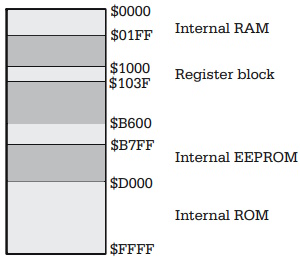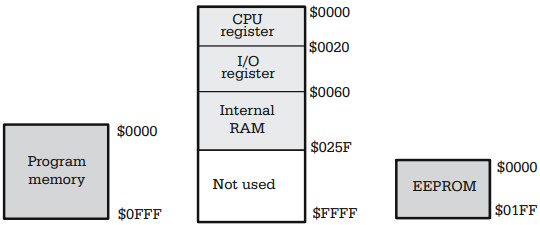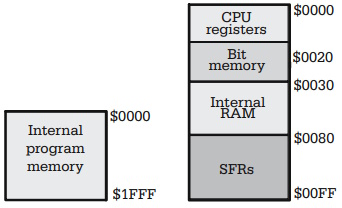
From the programmer's point of view, a microcontroller is a set of resources. Each resource is identified by one or more addresses in an address space. For example, the 68HC11E9 microcontroller has its internal RAM memory organized as 512 locations, having addresses in the range $0000-$01FF, the ROM memory occupies the addresses in the range $D000-$FFFF (12288 locations), and the I/O register block takes the address form $1000-$103F (64 locations).
The memory map is a graphic representation of how the resources are associated with addresses (see Fig. 1.3 for an example of a memory map).
Obviously, not all addresses are related to existing resources - in some cases it is possible to add external memory or I/O devices, to which we must allocate distinct addresses in the address space.
Normally, the memory map is determined by the hardware structure formed by the microcontroller and the external devices (if any), and cannot be dynamically modified during the execution of a program.
However, there are situations when, by writing into some special configuration registers, the user can disable resources (such as the internal ROM memory, or the EEPROM memory) or can relocate resources in a different area of the address space. But even in these cases, the access to the configuration registers is restricted, and the modification becomes effective after the next RESET.
Figures 1.3 and 1.4 show the memory maps for a microcontroller with Von Neumann architecture, MC68HC11E9, operating in single-chip mode, and for a RISC microcontroller, the AVR AT90S8535.

Fig. 1.3. Memory map for 68HC11E9 operating in single-chip mode

Fig. 1.4. Memory map for AT90S8515 operating in single-chip mode
Note, for the AVR microcontroller, the presence of three different address spaces, one for data memory and I/O registers, and two more for the program memory and the EEPROM.
The 8051 microcontrollers are considered to belong to the Harvard architecture, but they are CISC, and do not allow pipelining; therefore they look more like Von Neumann computers with the capability to access program memory, and data memory as different pages. The two distinct memory pages are accessed through the same physical bus, at different moments time in. Fig. 1.5 shows the memory map for an 8051 MCU operating in single-chip mode. There are two address spaces here too, one for the program memory and the other for data memory and special function registers.

Fig. 1.5. Memory map for 8051 operating in single-chip mode
One unique feature of this microcontroller is the presence of a RAM area, located in the address range $0020–$002F, which is bit addressable, using special instructions. This artifice allows the release of RAM memory by assigning some Boolean variables to individual bits in this area, rather than using a whole byte for each variable, because 8051 is low on this resource: only 80 RAM locations are available for variables and stack.
Standard 8051 microcontrollers do not have internal EEPROM memory.
About Microcontrollers in Practice

The book is structured into three sections. Chapters 1-8 aim to create a detailed overview of microcontrollers, by presenting their subsystems starting from a general functional block diagram, valid for most microcontrollers on the market. In each case, we describe the distinctive features of that specific subsystem for HC11, 8051 and AVR. This whole section has a more theoretical approach, but, even here, many practical examples are presented, mainly regarding the initializations required by each subsystem, or the particular use of the associated interrupts. The purpose of this section is to create a perspective that views the microcontroller as a set of resources, easy to identify and use.
Chapters 9-16 contain eight complete projects, described from the initial idea, to the printed circuit board and detailed software implementation. Here too, we permanently focus on the similarities between the microcontrollers discussed, from the hardware and software perspectives.
All chapters contain exercises, suggesting modifications or improvements of the examples in the book. Most exercises have solutions in the book; for the others the solutions can be found on the accompanying CD.
Finally, the appendices contain additional information intended to help the reader to fully understand all the aspects of the projects described in the previous sections. We chose to present these details separately in these appendices, in order to avoid fragmentation of the flow of the main text.
Stressing common characteristics and real applications of the most used microcontrollers, this practical guide provides readers with hands-on knowledge of how to implement three families of microcontrollers (HC11, AVR, and 8051). Unlike the rest of the ocean of literature on individual chips, Microcontrollers in Practice supplies side-by-side comparisons and an overview that treats the systems as resources available for implementation. Packed with hundreds of practical examples and exercises to foster mastery of concepts and details, the guide also includes several extended projects. By treating the less expensive 8-bit and RISC microcontrollers, this information-dense manual equips students and home-experimenters with the know-how to put these devices into operation. Click here to learn more.
More Computer Architecture Articles:
• Multithreaded Programming Process' and Threads
• How Computer Chips are Made
• Multi-Processor Scheduling
• Integrated Circuit Design Flow
• AMD's Phenom II Processor
• Shortest-Job-First CPU Scheduling Algorithm
• Dynamic Loading of Program Routines and Dynamically linked libraries (DLLs)
• Priority CPU Scheduling Algorithm
• Difference between Stack, Heap, and Queue
• Logical Versus Physical Memory Addresses

